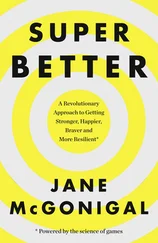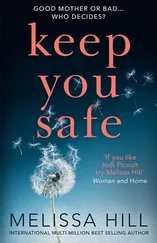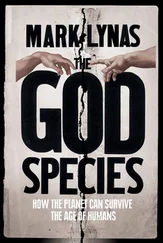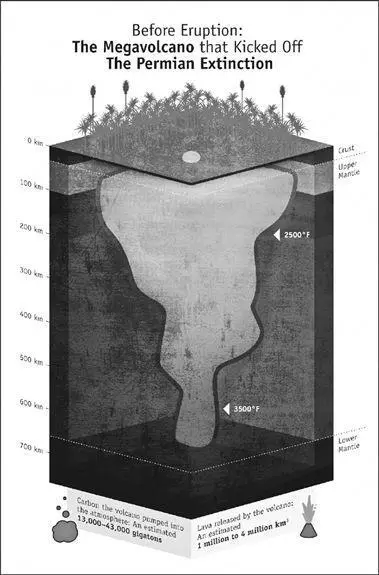
A cutaway view of the megavolcano in Siberia that led to the Permian mass extinction. (illustration credit ill.3)
(Click here to see a larger image.)
These new forms of life, the forerunners of so many animals and plants we take for granted today, almost didn’t make it. What was especially unusual about the Permian mass extinction was that it took out nearly every form of life. Unlike in other mass extinctions, which sometimes hit sea creatures but not land creatures, or animals but not plants, this extinction was absolute. As many species were lost at sea as on land. When the megavolcano pumped carbon into the atmosphere, a lot of that got dissolved into the oceans. The water grew warmer, which destroyed the habitats of shellfish, who are sensitive to temperature changes. It also grew more acidic. The shells of shellfish are made of calcium carbonate, which dissolves in acid. Many sea creatures didn’t survive simply because their offspring couldn’t form shells in a highly acidic ocean environment.
Meanwhile, on land, so many trees and plants died that the continent’s surface was “denuded,” as Payne put it. The result was shockingly rapid weathering. As acid-tinged rain poured from the sky, followed by hot winds, more soil poured into the oceans, further raising the levels of carbon and acid. Vast areas of the coastal seas became anoxic dead zones—regions completely purged of oxygen. With oxygen supplies low in the water, large fish could not survive, especially ones that lived close to the deeply damaged ocean’s surface.
Even insects, which generally survive everything, suffered extinctions. An estimated 9 out of 10 marine species and 7 out of 10 land species went extinct. Across the planet, carbon levels suddenly skyrocket in rocks from this period examined by Renne and his colleagues, which suggests that the dead bodies of plants and animals were quite literally piling up on land and at sea. As the plants rotted, they released even more carbon into the environment. The devastation was so complete that we see a “coal gap” in the layers of rock left behind from this era. Plant life, which decays into coal, was so sparse in the 10 million years following the end of the Permian that none of the fossil fuel could form.
The planet had already endured ice ages, greenhouses, cosmic rays, and speciation depression. But only in the Permian mass extinction were almost 95 percent of all species cut down. And it happened in just 100 thousand years—the blink of an eye in geological time.
Still, there were survivors. The Stanford geologist Payne showed me a rock that’s a slice of geological time from this period, where a layer of ocean-floor sediment filled with tiny shells is topped by a black layer of what looks like pure sludge. It’s easy to see that a diverse community of creatures was abruptly replaced by nothing but, well, slime. Payne and his colleagues have nicknamed this era Slime World, because the oceans were dominated by dark, oozing bacterial colonies, feasting on the dead bodies of their multicellular cousins.
On land, one of the great survivors was Lystrosaurus , an animal that managed to thrive. A heavy, clubfooted creature with a beaked snout and two tusk-like teeth, Lystrosaurus was a four-legged synapsid, or mammal-reptile hybrid. About the size of pigs, lystrosaurs were burrowing animals whose muscular hindquarters ended in short, wiggly tails. And they somehow managed to endure when even the precursors of the hardy cockroach were dying. They were herbivores, and their beaks probably allowed them to chomp on rough vegetation and dig for roots to eat.
For several million years after the end of the Permian, lystrosaurs were alone on a dead world. But they didn’t cower or retreat. Instead, they spread out as far as they could across the landmass that would one day fracture into the continents we know today. Their fossils have been found in Africa, Asia, and even Antarctica, which was a tropical region at the time. With no predators and no competition for their favorite foods, lystrosaurs could waddle anywhere they liked. They are, as far as we know, the only creatures ever to dominate our world so thoroughly: For millions of years, most four-legged land creatures were one type of lystrosaur or another.
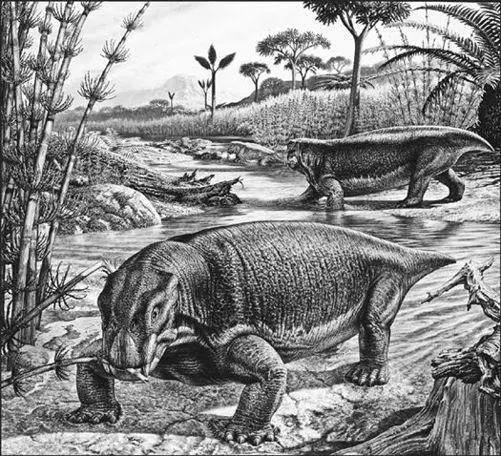
Lystrosaurus was one of the few land animals to survive the Permian mass extinction, and its progeny spread across the Southern Hemisphere during the early Triassic. (illustration credit ill.4)
Why did these creatures—our distant ancestors—survive when so many of their fellow creatures didn’t? Theories abound. The Permian expert Mike Benton said it’s possible that they were “just lucky.” More likely, he added, they were well adapted for a world with depleted oxygen. They lived in underground tunnels, so they had a natural way to escape the heat and fire of the initial volcanic eruptions. Plus, the air they were used to breathing in their burrows was likely to be low in oxygen and full of dust—sort of like the air after carbon has been saturating it for a few centuries. Their barrel chests held lungs of a tremendous capacity, which meant more oxygen uptake. Lystrosaurus had the right respiratory system at the right time.
Over time, Lystrosaurus ’s progeny repopulated the southern part of Pangaea, diverging into many subspecies. Their favored half of the supercontinent eventually broke off from the northern half and became its own continent, Gondwana (named after the southern Ordovician continent), packed with dinosaurs and proto-mammals. It took 30 million years for our planet to grow a robust ecosystem again, packed with predators and herbivores and a wide range of flora and fauna.
The Early Triassic Period (250 Million–220 Million Years Ago): Unraveling Food Webs
Those 30 million years of ecosystem struggles are their own story. Though every mass extinction unfolds differently, they all end when a new community of creatures has established itself—generally, a community that statistician Charles Marshall described as “completely different life-forms.” After the Permian, during the early millennia of the Triassic period, new communities of completely different life-forms rose and fell with alarming regularity. A new ecosystem would come together only to collapse in a few million years. Then another ecosystem would arise. This mass extinction just wouldn’t end.
Why did it take the planet so long to recover from the Great Dying? For answers, I visited Peter Roopnarine, a zoologist at the California Academy of Sciences who has a rather singular occupation among scientists. He’s developed a computer program that simulates food webs, the complex interplay between predators and prey within an ecosystem. Using this program, Roopnarine studies why the worst part of mass extinctions isn’t necessarily the fire, or the eruptions. It’s what comes afterwards, in the centuries of what scientists call “indirect extinctions” caused by food webs that are too unstable to support life.
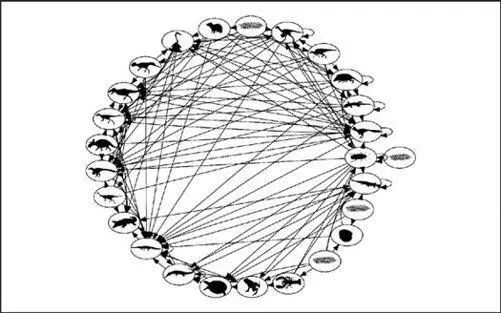
In this food web illustration created by Peter Roopnarine, the arrows between life-forms indicate who eats whom. This is a Cretaceous-era food web. (illustration credit ill.5)
The old computer game Wator offers a perfect example of a simple food web simulation. In it, red pixels stand in for sharks (predators) and green pixels for fish (prey) as they battle it out for supremacy of the sea. You can set a few simple parameters, such as how many sharks and fish there are to start, how often they breed, and how long it takes before they starve. Then you press “start” and watch generations unfold in seconds. When there are too many sharks, or the fish breed too slowly, the population of sharks eventually dwindles to zero and the waters of “Wator” become a sheet of uniform green. And that means you fail. What Wator reveals is that predators are as much at the mercy of prey as the reverse. Food webs can be knocked out of balance by life-forms at any point in the food chain.
Читать дальше
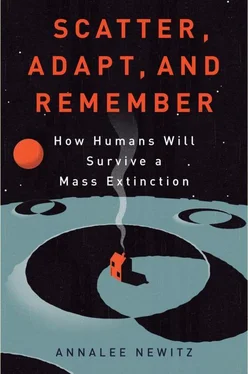








![Аннали Ньюиц - Автономность [litres]](/books/424681/annali-nyuic-avtonomnost-litres-thumb.webp)


